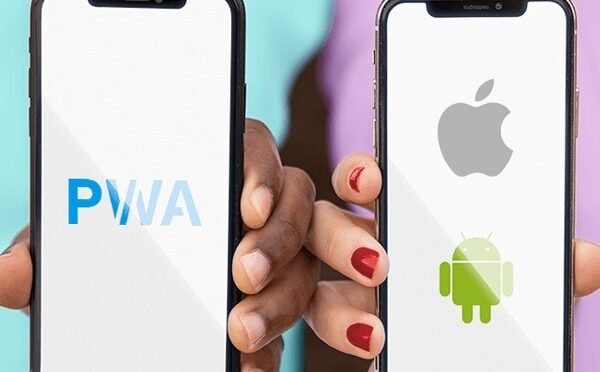Progressive Web Apps vs. Native Apps

In today’s fast-paced digital world, businesses must choose the right app type to connect with their audience. The decision between Progressive Web Apps (PWAs) and Native Apps can significantly impact a business’s user experience, costs, and overall strategy. Both app types offer unique advantages and challenges, and understanding the differences between them is crucial for making an informed decision.
This article explores the distinctions between PWAs and Native Apps, guiding businesses on which app format best suits their needs and goals.
Understanding Progressive Web Apps and Native Apps
What are Progressive Web Apps (PWAs)?
Progressive Web Apps (PWAs) are web-based applications that function like native apps but are accessible through a web browser. These apps can be installed on users’ devices and offer offline capabilities, push notifications, and quick updates. PWAs are universally compatible across different devices, making them an attractive option for businesses seeking broad reach without the need for separate app versions.
What are Native Apps?
In contrast, Native Apps are developed specifically for a particular operating system, such as iOS or Android. These apps must be downloaded from an app store and offer deeper integration with the device’s hardware and features, providing a more customized experience. Native Apps tend to perform better, leveraging the full power of the device for smoother interactions and faster performance.
Both PWAs and Native Apps have their own sets of strengths and limitations. PWAs excel in cross-platform compatibility and low maintenance, while Native Apps offer superior performance and richer features.
Key Differences Between Progressive Web Apps and Native Apps
Functionality and Integration
Native Apps outperform PWAs in terms of functionality. Since they are designed for specific platforms, Native Apps can access hardware features like GPS, cameras, and sensors. They can also operate without an internet connection, which makes them ideal for certain types of applications, like gaming or those requiring offline functionality.
On the other hand, PWAs rely on web technologies and cannot access device hardware as effectively. While PWAs can offer features like push notifications and offline access, they cannot integrate with a device’s hardware to the same extent as Native Apps. Additionally, Native Apps offer better performance for tasks requiring substantial processing power, such as video editing or gaming.
Installation and Updates
PWAs do not require installation from an app store and can be accessed directly through a web browser. This makes them easy to use and instantly available to users. Updates are also seamless, as PWAs refresh themselves automatically, ensuring that users always have access to the latest version without any manual intervention.
In contrast, Native Apps require installation from app stores, and users must manually update them. This can sometimes delay the update process and result in users using outdated versions of the app.
Advantages of Progressive Web Apps (PWAs)
Cost-Effectiveness and Accessibility
One of the major benefits of PWAs is their cost-effectiveness. Developing a PWA typically requires a single codebase that works across multiple platforms, reducing both development and maintenance costs. For businesses, this means reaching a larger audience without the need for separate versions for iOS and Android.
PWAs are also more accessible than Native Apps. Users can access them instantly through their web browsers, eliminating the need to download and install an app. This ease of access can improve user acquisition and retention rates, especially for businesses looking to expand their reach quickly.
Seamless Updates and Maintenance
With PWAs, businesses enjoy simplified maintenance and updates. Since the app is web-based, updates happen automatically, ensuring users always have the most up-to-date version. This eliminates the need for app store approvals and the manual update process required by Native Apps.
For developers, maintaining a single codebase for all platforms significantly reduces the operational burden and long-term costs. This can translate to a more reliable app that requires less attention from developers, allowing them to focus on enhancing the user experience.
Benefits of Native Apps
Superior Performance and Speed
Native Apps are known for their superior performance. Built specifically for a particular platform, Native Apps can leverage the full capabilities of the device’s hardware and software. This leads to faster performance, smoother transitions, and a better overall user experience. For tasks that demand high processing power, such as video editing or gaming, Native Apps provide a significant performance advantage.
Additionally, Native Apps can use advanced device features, such as multi-touch gestures, to enhance interactivity and improve usability. Businesses in industries like gaming or finance, where performance is critical, will benefit from the speed and responsiveness offered by Native Apps.
Enhanced User Experience and Features
Native Apps deliver a more immersive user experience, thanks to their ability to integrate seamlessly with a device’s operating system. This results in a more intuitive and engaging interface, as Native Apps can utilize native design elements that are familiar to users.
Native Apps also offer deeper integration with device features such as the camera, GPS, and contacts, enabling businesses to create highly personalized experiences. For instance, Native Apps can incorporate augmented reality (AR) or advanced security features, which PWAs cannot match in terms of integration.
Choosing the Right App for Your Business
Evaluating Business Needs
When choosing between a PWA and a Native App, businesses must first evaluate their unique needs. Factors such as target audience, budget, and long-term goals will all influence the decision. If your business aims to reach a broad audience across various platforms and requires a cost-effective solution, a PWA may be the better choice. Its cross-platform compatibility and easy access make it ideal for businesses looking to maximize reach without the need for separate versions.
However, if your business requires high performance, advanced features, and deep integration with device hardware, a Native App may be more appropriate. Industries that rely on smooth performance and robust user engagement, such as gaming, finance, and healthcare, tend to benefit from Native Apps.
Considering Long-Term Goals
Long-term business goals play a significant role in choosing between PWAs and Native Apps. If your goal is to scale rapidly and capture a diverse user base, a PWA may be the best fit. Its adaptability and ease of updates ensure your app can evolve with your business.
However, if your long-term vision focuses on building a strong brand with premium user experiences, investing in a Native App could be worthwhile. Native Apps offer superior performance and personalized experiences, which can help foster user loyalty and enhance engagement over time.
Conclusion
In conclusion, both Progressive Web Apps and Native Apps have their advantages and limitations. The decision ultimately depends on your business’s objectives, target audience, and available resources. PWAs are cost-effective, easy to update, and ideal for broad user engagement. Native Apps offer superior performance, better integration with device features, and a richer user experience.
By carefully considering your business needs and long-term goals, you can choose the app type. It best supports your strategic vision and delivers an optimal user experience.
Content written by-Tanya
Tanya is part of the expert content marketing team at ITCombine. She has an expertise of curating meaningful information that can be used by visitors in general. Tanya is also involved in creating Client specific stories and blogs.
Copyright © 2025 - itcombine.com.
All Rights Reserved.








